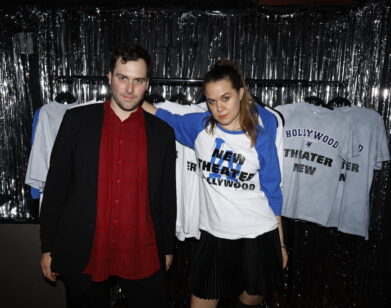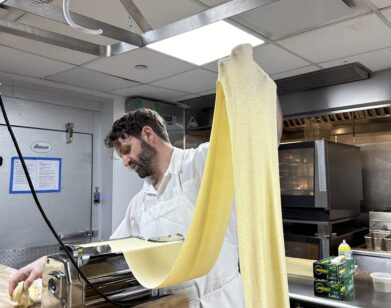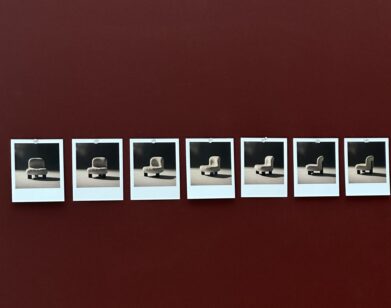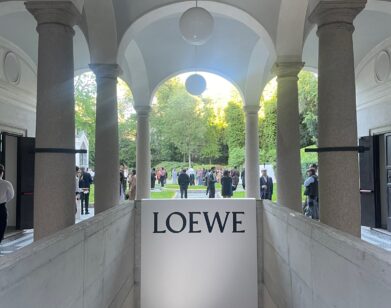Desi Santiago Plays Devil’s Advocate at the W
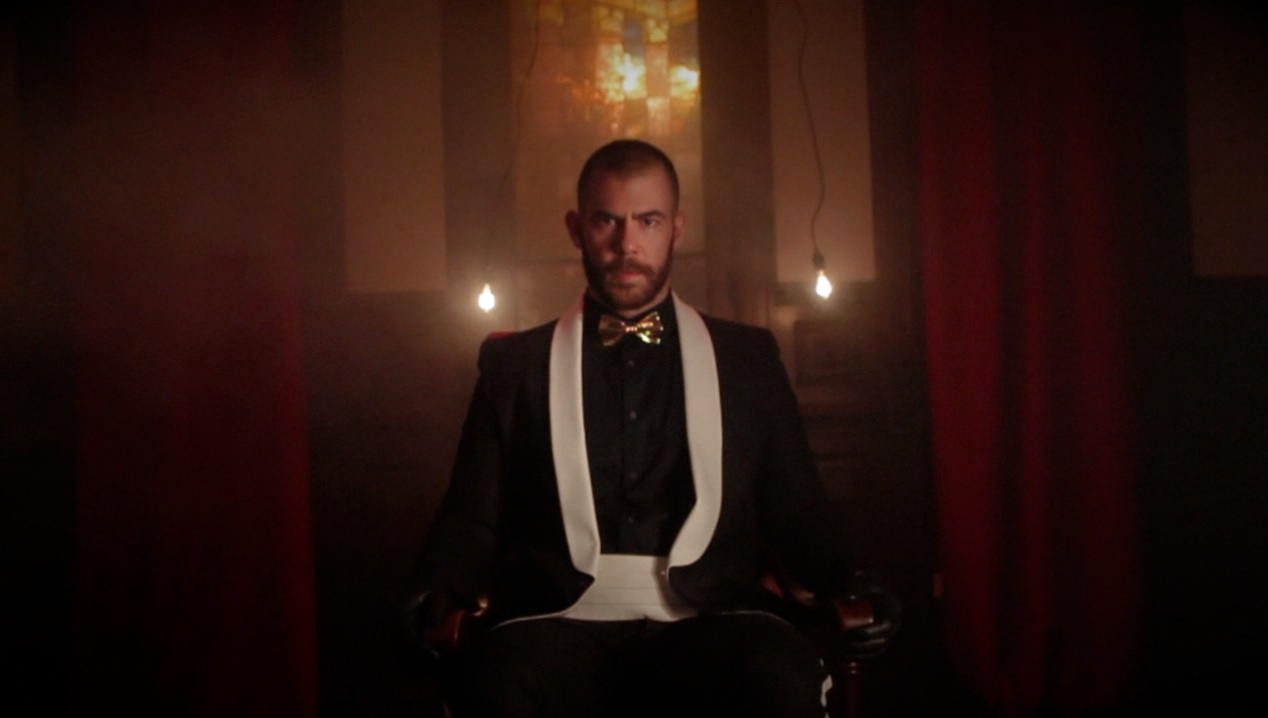
ABOVE: DESI SANTIAGO AT THE W NEW YORK
For many, the word “casino” may elicit daunting memories of games lost and money wasted. For a lucky few, it triggers the opposite—a feeling of pure ecstasy after the slots stopped moving at a pivotal moment or the dealer dealt a perfect hand. Rarely, though, does it evoke a sense of smell, sound, or high-concept fashion—but with an installation by performance and visual artist Desi Santiago at the W New York, “casino” assumes a new form.
At Art Basel: Miami Beach in 2012, the New York-based artist redesigned the exterior of the Lords Hotel, and now he is transforming the interior of the W. The hotel’s two EWOW suites (equivalent to Presidential Suites elsewhere) will temporarily become a multisensory pop-up casino, Casino Diabolique. “I created a sexy surrealist casino parlor inspired by the Black Lodge from Lynch’s Twin Peaks remixed with Kubrick’s The Shining,” Santiago explains.
Like Agent Cooper maneuvered his way through the Black Lodge, guests will enter Casino Diabolique by passing through deep red curtains. Once inside, every guest has one chance to play each of three uniquely designed games. “There are all these layers upon layers of chance being built into the whole experience,” Santiago continues. From the moment guests step through the door, their fate at the casino is left to chance.
Santiago had a little help: he collaborated with Hood By Air to create a wardrobe, Tomas Delucia of The Sense Society for the casino’s custom smell, Azari & III to compose an electronic soundtrack (a preview of which is below), and New York nightlife expert Seva Granik to design dramatic lighting. Before its opening, Santiago told us about the conceptualization and physical realization of his casino over the phone.

EMILY MCDERMOTT: How did you decide whom you wanted to work with?
DESI SANTIAGO: The people aren’t random. They’re all people whose work I love. When the W is giving me an opportunity like this, it’s a vessel. It’s a vehicle for me. It’s like I got candy. I’m like, “Okay, great. I can bring this person in that I really want to work with,” because here is an opportunity to do something really cool, that a lot of people will experience and a lot of people will see. Everything is always intuitive. The tarot reader that I’m working with is a contemporary artist, Jen DeNike. She has shows at the MoMA, the MoMA owns her work, but she’s also a tarot reader. I knew her as an artist, but I never realized that she actually did tarot reading. I have a powerhouse coming. I’m really excited.
MCDERMOTT: I know there are three games. Can you talk a bit about them?
SANTIAGO: When you check in, there’s someone in front of the fire—there will be a burning fireplace—you get three chips and then take an elevator to the 10th floor. All of a sudden, that’s where the intervention begins. There’s a red curtain that blocks up the hall; you walk through the curtain and then you’re greeted. One suite has three games, and everybody is allowed one opportunity with each game.
There is one called Numero, and it’s basically like blackjack, but with this game the goal is not just to get the highest hand. You have to get blackjack. There’s the Zodiac Roulette, which is a roulette wheel, but I customized the top so the different numbers correspond with different zodiac symbols. I think it’s really interesting to see how people decide what to do. It’s like, are you playing your own zodiac sign? Are you playing someone’s that you care for? What’s the drive behind these intuitive choices? That’s what I like.
The third game is one I made up called the Pendulum. It’s a table game, and there’s a multitude of holes, all these openings in the tabletop. For that, I have a dealer who is the pendulum reader. In order to play the game you have to ask her one yes-or-no question and she will give you your response. Then you’re allowed to choose [one hole]. She’ll use the pendulum, which is magnetic, to go down into the hole. If a steel ball emerges, you’ve won a prize.
Then I have the other suite, which I’ve been calling the “Mastermind Lounge.” That’s where the bar and my tarot reader are. With the tarot reader, not everybody is going to have a chance to have a reading by her. There’s going to be a certain number who get that chance.
MCDERMOTT: So with all of these layers of chance, obviously you have—I don’t want to say obsession, but you really like the idea of chance. Where does that stem from?
SANTIAGO: That totally stems from my childhood. I grew up in a family of gamblers. My parents owned a tavern, and we lived above it. They hosted this bar with all these people, but they were also bookies for horse races. It’s also part of Latin culture— always seeing signs and symbols within things. When you meet someone, you find out where they live, and then you use their address number to play. That becomes a lucky number. Things always become lucky signifiers; things that appear to you very intuitively embody luck. I’m trained to think that way and to live my life that way. I’m not a gambler with money, but I’m a gambler by taking chances with the projects I make up and in my life. I do what I want, and hopefully everything falls into place. So far I’ve been lucky. I’m a believer in that if you just take a chance, things are going to make sense and will unravel in the right way, in an authentic way. That’s where the whole idea of chance upon chance came from—that’s the way I live. It’s me showing other people that you have one chance, go for it.
MCDERMOTT: What’s one chance you’ve taken that is something not everyone would have done?
SANTIAGO: I think moving to New York when I was 17 years old. I originally came to New York to go to Parsons, and I dropped out after a semester. It was 1990—club-kid heyday—and I took a chance and just left school. I was like, “I’m going to do what I want to do and have fun,” but beyond have fun, be creative and always live within the creative space. That was a big chance I took when I was younger, but I’m still here today in that state. I’ve always been a creative being here in New York. I make up these insane projects, and sometimes it blows my mind that people are supporting it. [laughs] I’m like, “These kind of make no sense, but okay, great. Someone’s into it, I’m going to do it.”
MCDERMOTT: [laughs] That’s what matters. As long as people are into it.
SANTIAGO: [laughs] That’s what matters, yeah. New York is amazing in that way. You can really manipulate your own reality and create what you want to be. Things that don’t have a normal identity or label—make it up and you can do it. If you believe in it, people believe in it.
MCDERMOTT: That seems like how the casino might be, too, like a world that you can make what you want of it. Do you think you reflect New York in the casino?
SANTIAGO: I think so. I really do. It’s about how you perceive it. It’s about opportunity, chance, risk, and coming together as a shared experience. I think it’s a really paralleled metaphor.
MCDERMOTT: You said that space dictates almost everything that you do. What is it like working in a hotel opposed to a more structured environment like a museum?
SANTIAGO: It’s different because hotels are more transient spaces, which I dig. I like the idea that it’s a destination for people. They’re coming in and out. The energy is constantly shifting. I think there’s a different energy within a hotel than in an institution. An institution is much more static. It’s grounded. A hotel, especially the W, is cool. They’re fun, there’s stuff going on. It’s more bubbling. [The W] is really into this art, music, and design crossover, so it makes sense to bring what I’m doing there. I feel energy in spaces differently. I connect with space because that’s the canvas I’m using. I need to feel it and the hotel energy is very electric.
MCDERMOTT: How do you think this transient space and electric feel of it made the casino different from some of your other works?
SANTIAGO: There is a lot of energy happening in this experience that is activated by the people coming into it, whereas some of my other installations involve sculpture and it’s more about observing the sculpture, observing the work and the relation of you to this work. With this you are part of the work. You’re really activating the work.
MCDERMOTT: What is your philosophy toward art?
SANTIAGO: I think it’s really just following your gut. The work that I do is much more emotionally based. It comes from an instinct, an obsession, a compulsion. I think you have to have the compulsion to create. That’s my philosophy toward my work. I’m compelled to do it. I have no choice. I have to do it because it’s in my head and I need to release it.
MCDERMOTT: It’s like Rilke with writing—you ask yourself if you must write and if the answer is “I must,” then that means you’re a writer.
SANTIAGO: Yeah, I have no choice. In that way, I feel I’m a medium. I use this magic on my work. I’m a medium, I channel things and it’s art. It’s what I have to do. It pops in my head and I have vision of what I want it to be like. It’s an art of getting to that point and I develop a tunnel vision toward it.
DESI SANTIAGO’S CASINO DIABOLIQUE PREMIERES AT THE W NEW YORK TONIGHT, NOVEMBER 14, AND IS OPEN TO THE PUBLIC NOVEMBER 15 THROUGH 17 FROM 8 TO 10 P.M. REGISTER TO PLAY HERE.

